Il mango (Mangifera indica L Family Anacardiaceae) è il secondo raccolto di frutta in Pakistan. Attualmente è coltivato su una superficie di 93,42 mila ettari con una produzione di 915,7 mila tonnellate Tabella-1. La superficie coltivata a mango è aumentata, ma l'aumento della produzione è relativamente lento. I principali distretti di coltivazione del mango nella provincia del Punjab sono Multan, Bahawalpur, Muzzaffargarh e Rahim yar Khan. Nella provincia del Sindh è coltivato principalmente a Mir pur Khas, Hyderabad e Thatta nella provincia di NWFP è coltivato a Peshawar e Mardan. Il clima del Sindh si riscalda circa un mese prima rispetto al Punjab, il che ha dato alla provincia il privilegio di coltivare varietà precoci di mango. Successivamente, una nuova tendenza alla coltivazione di varietà tardive nel Punjab ha ricevuto un'ampia popolarità che ha esteso il periodo di mercato e ha aumentato le eccedenze esportabili.
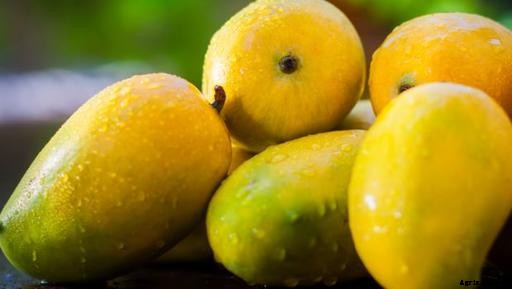
Questo delizioso frutto è nutrizionalmente superiore, fonte di numerose vitamine e minerali. Il Pakistan produce il 5,86 percento di mango del mondo, essendo il terzo produttore. La sua esportazione sta progredendo con conseguenti notevoli guadagni in valuta estera. L'esportazione di mango, compreso il Medio Oriente, ha trovato la sua strada anche nel Regno Unito e in altri mercati europei. Si ritiene che la domanda salirebbe fino al 50 percento, dato il giusto impulso e l'espansione dell'esportazione in Germania, Giappone Cina e Hong Kong.
Le condizioni ecologiche adatte alla coltivazione del mango sono:
Il mango di solito assume una graziosa forma a cupola che ombreggia il tronco principale. Non si pratica però la potatura, ogni anno dopo la raccolta dei frutti malata, essiccato, i rami spezzati e quelli che toccano il suolo dovrebbero essere potati. Per ringiovanire il frutteto ogni 3-4 anni si consiglia di rimuovere il 15-20% del legno vecchio.
La raccolta deve essere effettuata quando il frutto è completamente sviluppato e maturo. La caduta naturale del frutto è la principale indicazione che il frutto è pronto per la raccolta. Varietà diverse in aree diverse maturano in tempi diversi. Nel Sind, le varietà di mango iniziano a maturare da maggio a giugno. Nel Punjab la maturazione inizia da giugno e prosegue fino a metà agosto. Nella NWFP, la raccolta è successiva che aiuta a prolungare il periodo di disponibilità dei manghi. Le rese attese variano da 40 a 100 kg per albero.
I sintomi si possono notare sull'infiorescenza, peduncolo di infiorescenza, foglie e frutti giovani. I sintomi caratteristici della malattia sono la crescita polverosa superficiale bianca del fungo su queste parti. I fiori efficaci possono cadere prematuramente e i giovani frutti possono rimanere sull'albero fino a raggiungere le dimensioni del marmo e poi cadere prematuramente. La caduta di fiori e frutti giovani infetti non fecondati porta a gravi perdite di raccolto (20-80%).
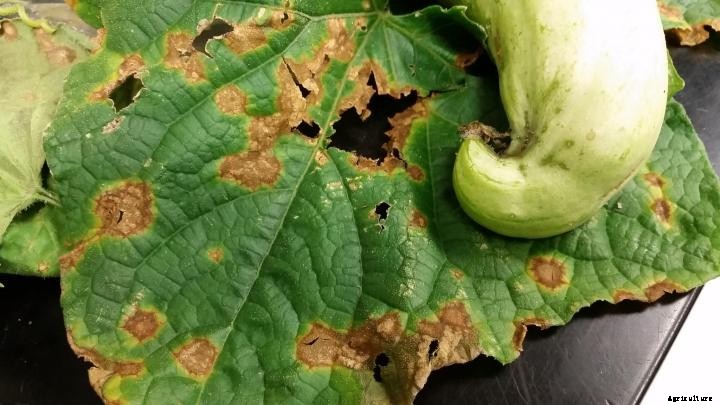
L'antracnosi si manifesta in diverse parti dell'albero di mango. Sull'infiorescenza, i primi sintomi della malattia sono la produzione di macchie bruno nerastre sui peduncoli e sui fiori. Piccole macchie nere compaiono sulle pannocchie e sui fiori aperti, che gradualmente si ingrandiscono e causano la morte dei fiori. I fiori infetti cadono, lasciando le punte più persistenti sui peduncoli, questo porta a gravi perdite di raccolto (10-90%). 95-97% U.R. eccessiva in azoto.
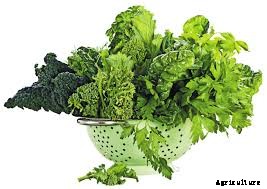
La malformazione è una seria minaccia per le aree di coltivazione del mango del Pakistan in quanto provoca perdite di raccolto fino al 70%. Recenti scoperte hanno dimostrato che la malattia può essere di origine fungina. Due distinti tipi di sintomi descritti dai lavoratori sono la malformazione vegetativa (MV) e la malformazione floreale (MF). La malformazione vegetativa è più pronunciata nelle giovani piantine così come nelle piantine che nelle piante innestate. Le piantine colpite hanno sviluppato eccessivi rami vegetativi, che sono di crescita limitata, gonfio e con internodi molto corti.
La malformazione dell'infiorescenza (MF) è una malattia dell'infiorescenza. I sintomi più caratteristici di (MF) sono la riduzione e la compattezza degli internodi che danno alla malformazione un aspetto simile a una scopa.Materiale da innesto infetto e ferite
Attualmente, non è possibile sostenere misure di controllo definite per la malformazione del mango. Tuttavia quanto segue può ridurre l'incidenza di malformazioni

La pianta di mango è più o meno soggetta a varie malattie fogliari che sono menzionate di seguito, ma le più importanti sono discusse in dettaglio:
I sintomi caratteristici appaiono come macchie ovali o irregolari da marrone a marrone scuro di varie dimensioni sparse su tutta la superficie fogliare. In condizioni di umidità, il fungo cresce rapidamente. Le foglie giovani sono più inclini ad attrarre rispetto a quelle più vecchie. L'attacco di insetti può facilitare l'ingresso di agenti patogeni con conseguente forte incidenza di malattie.
L'infezione fogliare può essere controllata con spruzzi di fungicidi a base di rame durante la primavera e dopo la stagione dei monsoni.
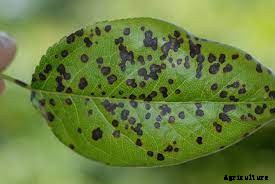
I sintomi appaiono inizialmente piccoli, macchie circolari brunastre sulla superficie delle foglie. Più tardi, un'alta concentrazione di macchie nere marroni si verifica uniformemente sulla lamina fogliare. I sintomi sono più evidenti nella parte inferiore delle foglie. Le foglie tenere risultano essere più suscettibili di quelle mature.
La malattia può essere controllata con un regolare programma di irrorazione sul campo, compresi i fungicidi a base di rame.
sulle foglie, minuscole lesioni impregnate di acqua da irregolari a angolari sollevate sono solitamente affollate all'apice. Sulle foglie giovani gli aloni sono più grandi e distinti, mentre sulle foglie più vecchie, sono strette potrebbero essere osservate solo in controluce. In caso di infezioni gravi, la foglia diventa gialla e cade.25-30 0C e>90% U.R. Tempo piovoso
Ispezione regolare dei frutteti, l'igiene e la certificazione delle piantine sono raccomandate come misure preventive contro la malattia.
Spray di fungicidi a base di rame è stato trovato efficace nel controllare il cancro batterico.
La malattia è più comune sui frutti giovani e durante il transito e la conservazione. L'infezione latente durante la fase pre-raccolta è responsabile dei marciumi post-raccolta. In deposito, vengono prodotte macchie nere. Inizialmente le macchie sono rotonde ma in seguito formano grandi chiazze irregolari sull'intero frutto le macchie hanno grandi crepe profonde e il fungo penetra in profondità nel frutto causando un esteso marciume.
Le infezioni pre-raccolta possono essere gestite spruzzando fungicidi a base di rame dopo il completamento di forti piogge.
Le infezioni post-raccolta possono essere gestite come spray pre-raccolta nel campo per ridurre l'infezione latente e il trattamento della frutta con acqua calda/fungicidi dopo la raccolta per sradicare l'infezione latente rimasta.
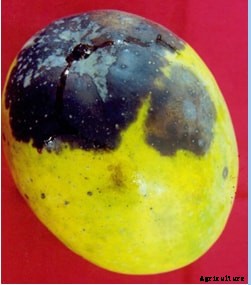
Il frutto durante la maturazione diventa improvvisamente da marrone a nero tipicamente all'estremità dello stelo. Entro due tre giorni il frutto intero diventa nero e la malattia progredisce verso il basso, coinvolgendo così metà della superficie dei frutti. Anche se spesso si osservano anche il rossore del frutto intero. La pelle interessata rimane soda, ma il decadimento si deposita nella polpa sottostante ed emette un odore sgradevole.
Declino è un termine generale e la pianta di mango è affetta da diversi disturbi del declino che sono solitamente associati a stress biotici e abiotici.
Gli importanti disturbi del declino del mango sono descritti di seguito:
La malattia è evidente durante tutto l'anno, ma è più evidente nei mesi di ottobre e novembre. È caratterizzato dal disseccamento dei ramoscelli dall'alto verso il basso, in particolare negli alberi più vecchi, seguito dal disseccamento delle foglie che dà l'aspetto di una bruciatura da fuoco. Le foglie superiori perdono il loro colore e gradualmente si seccano. L'essiccazione della foglia intera è accompagnata dall'arrotolamento del margine verso l'alto. Tali foglie avvizziscono, cadono nel giro di un mese lasciando nudi i ramoscelli avvizziti, che è il sintomo caratteristico nella fase avanzata della malattia.
Siccità, dolore duro, alta temperatura, alberi deboli, bruciatura del sole, alta umidità, carenza nutrizionale e danni fisici.
La malattia produce aree necrotiche nere allungate sui ramoscelli. Le foglie cadono lentamente durante l'ascesa e alla fine cadono. I rami molto giovani iniziano ad asciugarsi dalla punta verso il basso. lesioni, attacco di insetti, pianta debole ad alta temperatura, stress idrico, gelo e danni fisici.
I ramoscelli malati che giacciono sul pavimento del frutteto dovrebbero essere raccolti e tutti i ramoscelli infetti dell'albero dovrebbero essere potati e bruciati.
Gli spray fogliari di fungicidi a base di rame riflettono un buon controllo.
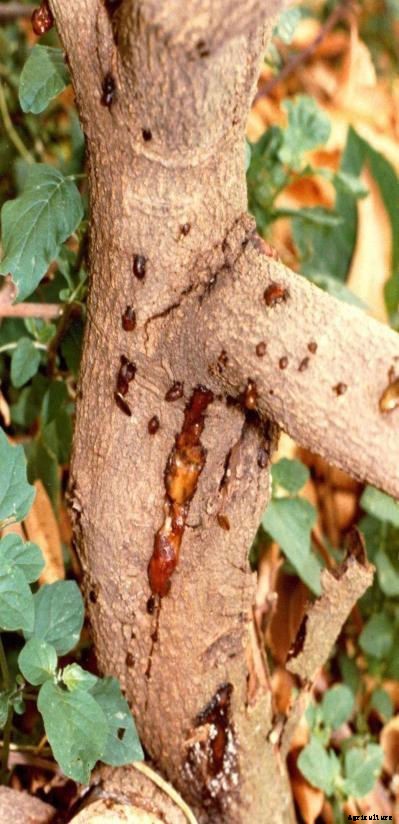
Circa il 30-40% dei giovani alberi di mango è affetto dalla gommosi soprattutto quando l'albero di mango è piantato in terreni sabbiosi ma la sua prevalenza è stata notata anche in altri terreni di coltivazione del mango. La malattia è caratterizzata dalla presenza di un'abbondante trasudazione di gomma sulla superficie del legno colpito, corteccia del tronco e anche sui rami più grandi ma più comune sui rami fessurati. Nei casi più gravi, goccioline di gomma gocciolano sul gambo e la corteccia diventa marrone scuro con crepe longitudinali.
La fessurazione della corteccia è caratterizzata dallo sviluppo di profonde crepe longitudinali. Il radicamento non è associato alle crepe ma il legno sottostante si trova gravemente butterato. Si notano anche tasche gengivali insieme alle crepe. Successivamente la corteccia viene essiccata e strappata con conseguente effetto cinturante, ingiallimento e caduta delle foglie seguita dalla caduta dei rami.
Controllo:-
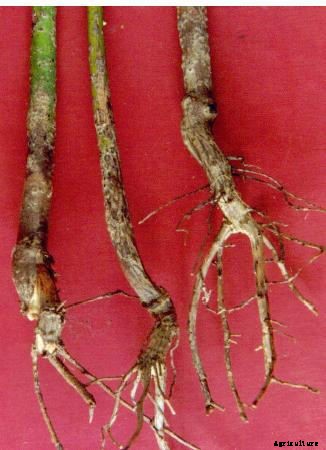
L'infezione si verifica al/o al di sotto del livello del suolo nelle zone ricoperte d'acqua da circolari a irregolari. Queste macchie si allargano e alla fine cingono l'intera base dello stelo. A causa della putrefazione, i tessuti malati diventano molli, marrone scuro o nero.
Trattamento del suolo con tiofanato metile, si raccomanda carbendazim o ossicloruro di rame a 2 g/ft2.
Durante il periodo di crescita qualsiasi fungicida a base di rame dovrebbe essere spruzzato sulle piante.
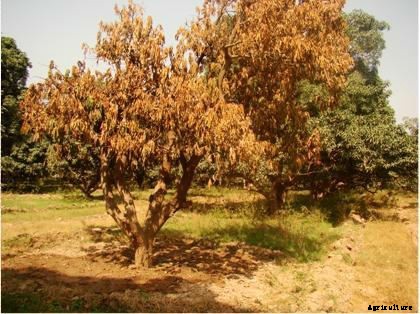
La sindrome della morte improvvisa del mango (MSDS) è diventata un'importante malattia in Pakistan dal 1997 che è strettamente associata alle infezioni da Ceratocystis fimbriata, probabilmente in concerto con funghi Botryosphaericaceous come Lasiodiplodia theobromae. L'irrigazione impropria e le lesioni alle radici sono stati trovati come i principali fattori predisponenti per questa malattia. Gli alberi di mango colpiti hanno sintomi di avvizzimento. I cancri possono svilupparsi su aree di decolorazione vascolare e i cancri possono trasudare gengiva dallo stelo. Le foglie appassite in genere diventano secche e arricciate piuttosto improvvisamente, ma rimangono attaccate all'albero per diverse settimane. È una malattia grave e aggravante giorno dopo giorno per cui piante di mango apparentemente sane muoiono in pochi giorni e sta distruggendo la preziosa ricchezza del Pakistan. Finora è stato osservato un tasso di mortalità del 4-12% in diverse aree di coltivazione del mango del Pakistan.
La diagnosi precoce è molto importante per la corretta gestione di questa malattia. A questo scopo gli scienziati hanno diviso questa sindrome in cinque categorie (0-5 stadi) con saggezza collettiva. La presentazione pittorica dettagliata di ogni fase è stata sviluppata per le linee guida dei coltivatori di mango nell'ambito del progetto ASLP. Tuttavia alcuni punti importanti vengono discussi qui.
Sradica le piante mostrando 3, 4 e 5 fasi immediatamente e trattare il terreno con fungicida. Si raccomanda anche la solarizzazione del suolo di quest'area.
Trattare le piante che cadono in 1 e 2 fasi nel modo seguente:
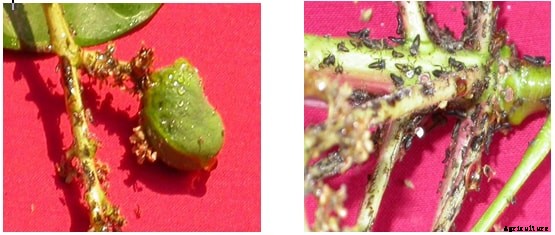
Le Ninfe a forma di cuneo e gli insetti adulti pungono e succhiano la linfa delle parti tenere, riducendo il vigore delle piante e in particolare distruggendo l'infiorescenza e provocando la caduta dei frutti. La foratura pesante e il drenaggio continuo della linfa provoca l'arricciamento e l'essiccazione del tessuto infestato. Inoltre danneggiano il raccolto espellendo una sostanza dolce appiccicosa che facilita lo sviluppo di muffe fuligginose.
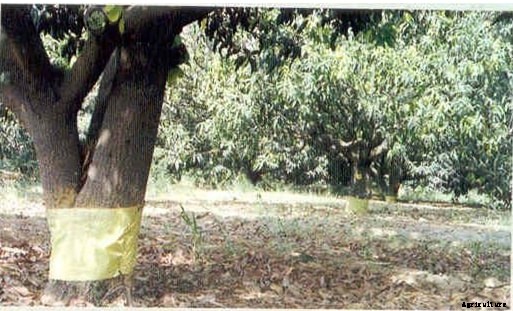
Gli insetti adulti sono ricoperti di polvere biancastra e colonizzano tra cortecce di tronchi d'albero, giovani germogli e pannocchie. Le ninfe salgono sugli alberi e si depositano sulle infiorescenze provocando la caduta dei fiori, che interessano l'allegagione. Inoltre espellono la rugiada di miele, una sostanza appiccicosa, che facilita lo sviluppo di fumaggine).
Sintomi:le larve scavano nel tunnel dell'asse dell'infiorescenza e la distruggono completamente. Il danno da E. indica provoca la piegatura e l'essiccazione delle infiorescenze. Il secondo attacco inizia all'allegagione quando i giovani vermi si infilano in questi teneri frutti che ingialliscono lentamente e alla fine cadono. Il terzo attacco è sulle tenere "nuove foglie che circondano l'infiorescenza". Il più dannoso è il primo attacco in cui l'intera infiorescenza viene distrutta. L'infiorescenza mostra una crescita stentata e il suo asse si piega, nel punto di ingresso della larva (Fig. 7 e 8).
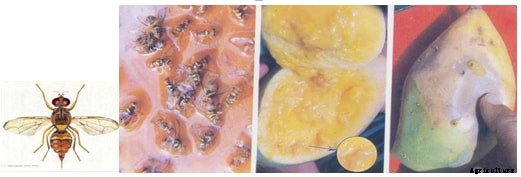
Sintomi:la femmina perfora la parete esterna dei frutti maturi con l'aiuto del suo ovopositore appuntito e inserisce le uova in piccoli grappoli all'interno del mesocarpo dei frutti maturi. Alla schiusa, i vermi si nutrono di polpa di frutta ei frutti infestati iniziano a marcire a causa di un'ulteriore infezione secondaria.

Sintomi:inizialmente i bruchi si nutrono gregariamente sulla superficie fogliare mediante raschiatura/Più tardi formano una rete di teneri germogli e foglie insieme e si nutrono all'interno. Diversi bruchi possono essere trovati in un singolo grappolo di foglie palmate.
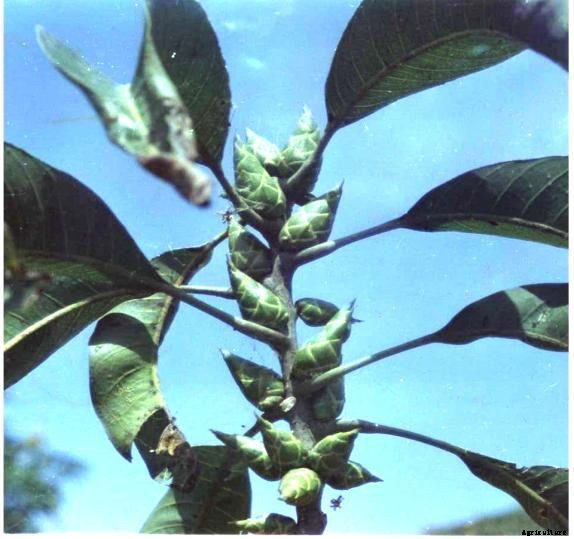
Sintomi:le ninfe emergono ad agosto-settembre e succhiano la linfa cellulare dalle gemme adiacenti. Come risultato dell'alimentazione, le gemme si sviluppano in galle verdi coniche dure. Le galle si vedono solitamente durante settembre-ottobre. Di conseguenza non c'è fioritura e allegagione. Le ninfe trascorrono l'inverno all'interno delle galle.
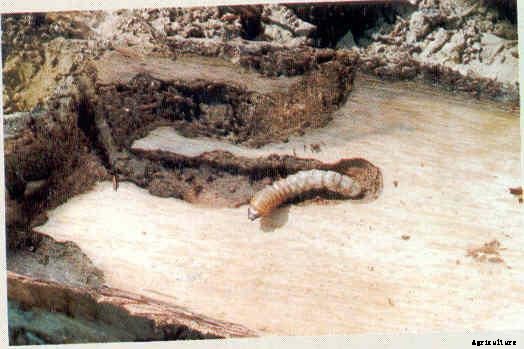
Sintomi:il danno è causato dalle larve alle radici o agli steli. Le larve dopo la schiusa delle uova si nutrono prima di corteccia e creano cavità irregolari. Crea gallerie che possono essere scavate verso l'alto, con conseguente essiccamento dei rami
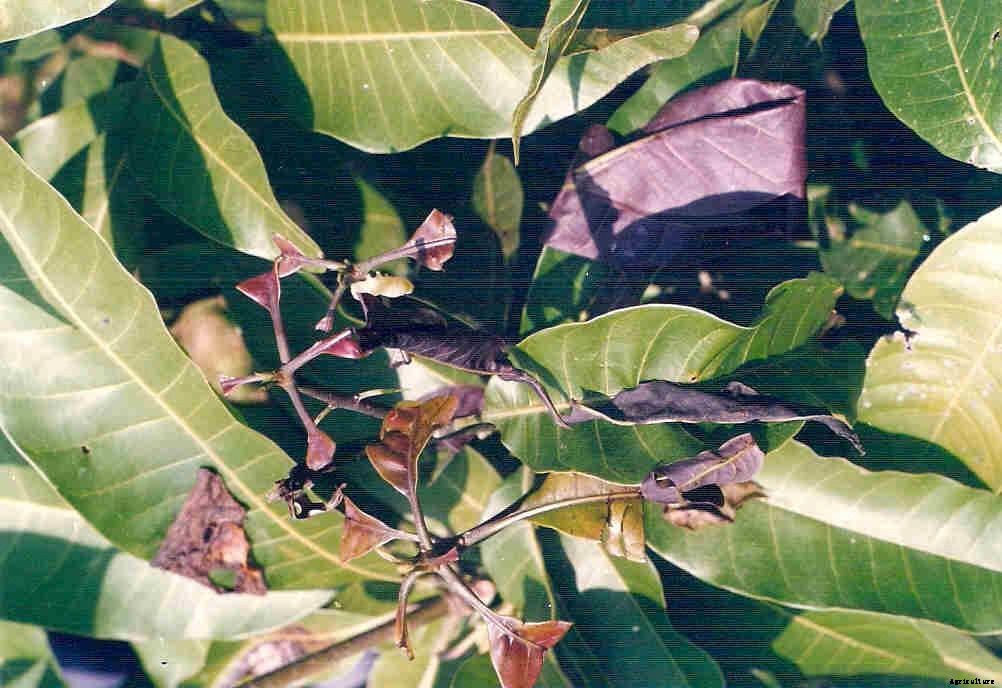
Sintomi:le larve si sono formate nelle giovani foglie tenere durante il mese di agosto e il bruco appena schiuso si è formato nella costola centrale. Dopo un paio di giorni, si foravano in teneri germogli vicino al punto di crescita scavando un tunnel verso il basso, gettando i loro escrementi con conseguente caduta delle foglie e avvizzimento dei germogli terminali.
Sintomi:il bruco tesse una rete di seta marrone a zig-zag simile a un nastro sull'albero che consiste dei loro escrementi e particelle di legno. Le larve creano anche tunnel di riparo all'interno dove riposano.
Sintomi:Le ninfe e le squame adulte succhiano la linfa delle foglie e di altre parti tenere riducendo il vigore delle piante. Inoltre espellono la melata che aiuta nello sviluppo di muffe fuligginose su foglie e altre parti tenere.
Sintomi:le ninfe e gli adulti lacerano i tessuti e succhiano la linfa delle cellule trasudanti. C. indicus e R. cruentatus si nutrono di foglie e S. dorsalis in fioritura, e giovani frutti. Le specie che si nutrono di foglie si nutrono di mesofillo vicino alle punte delle foglie. Le foglie colpite mostrano una lucentezza argentea e portano piccole macchie di materia fecale.
Se l'infestazione è grave, può essere controllato da dimetoato (0,1,5%) o monocrotofos (0,1%)
Sintomi:grave parassita di anacardi, occasionalmente danneggia il mango e altre colture da frutto. L'adulto è un insetto bruno-rossastro con la testa nera, torace rosso, e addome bianco e nero. Le uova vengono inserite nell'epidermide dei teneri germogli e nell'asse dell'infiorescenza. Adulti e ninfe si nutrono di piccioli, teneri germogli e nervature delle foglie che causano lesioni necrotiche.
Spray Dimetoato (0.05) o chinalphos (25 EC) 2 ml/litro.
Sintomi:un grave parassita in Orissa, Bengala occidentale e Andhra Pradesh costiero. Il parassita è attivo da gennaio a maggio Gli adulti depongono le uova sui frutti. Dopo la schiusa, le larve si sono trasformate in frutti. I bruchi completamente cresciuti (25 mm) hanno bande rosse sul corpo alternate a bande bianche. Il foro d'ingresso è tappato con escrementi. I frutti colpiti marciscono e cadono prematuramente.
Sintomi:minuscoli bruchi scavano sotto le epidemie dorsali delle foglie tenere e si nutrono all'interno, a causa della comparsa di vesciche bianche grigiastre sulle foglie.
Sintomi:le formiche si intrecciano e cuciono insieme alcune foglie, di solito in cima ai rami e costruiscono i loro nidi. Le formiche sono carnivore e predano piccoli insetti. Però, il danno indiretto è causato dalla protezione di insetti come afidi e squame, che espellono la rugiada di miele.
Sintomi:I bruchi attaccano l'infiorescenza e se non controllati provocano pesanti perdite per ridotta fruttificazione.
Per una gestione efficiente spruzzare Monocrotophos o Dimetoato 1 ml/l all'inizio della comparsa delle pannocchie.
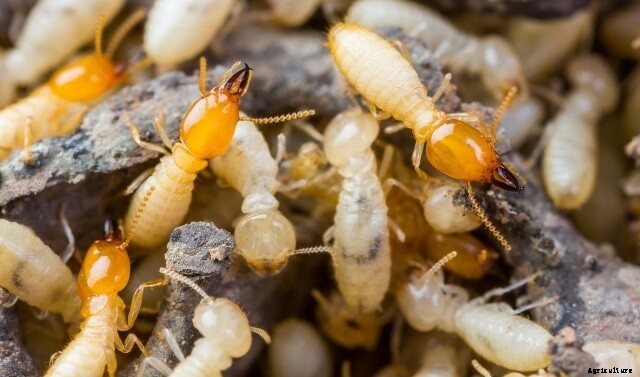
Sintomi:le termiti sono di colore bianco, timido alla luce e rimanere sottoterra. Si nutrono di radici o si muovono verso l'alto creando dei tunnel. Costruiscono gallerie di fango su tronchi d'albero e sotto la protezione di queste gallerie; si nutrono della corteccia dei tronchi.
Rimuovere le gallerie di fango sul tronco e tamponare o spruzzare il tronco con Malathion (1,5 ml/l).
Dopo due mesi, inzuppare il terreno alla base dell'albero con clorpirifos 1,5 ml/l.
Sintomi:l'agente patogeno attacca l'infiorescenza, fogliame, fusto dell'infiorescenza e frutti giovani con crescita polverosa superficiale bianca del fungo che ne determina la diffusione. The sepals are relatively more susceptible than petals. The affected flowers fail to open and may fall prematurely (Fig 28). Dropping of unfertilized infected flowers leads to serious crop loss. Initially young fruits are covered entirely by the mildew. When fruit grows further, epidermis of the infected fruits cracks and corky tissues are formed. Fruits may remain on the tree until they reach up to marble size and then they drop prematurely.
Infection is noticed on young leaves, when their colour changes from brown to light green. Young leaves are attacked on both the sides but it is more conspicuous on the grower surface. Often these patches coalesce and occupy larger areas turning into purplish brown in colour. The pathogen is restricted to the area of the central and lateral veins of the infected leaf and often twists, curl and get distorted.
Symptoms:The pathogen causes leaf spot/leaf blight, wither tip, blossom blight and fruit rots. On leaves characteristic symptoms appear as oval or irregular vinaceous brown to deep brown spots of various sizes scattered all over the leaf surface. Later lesions get blighted and rupture and show, shot hole symptom
Young leaves are more prone to attack, than older ones. Petiole, when affected, turns grey or black. Disease also produces elongated black necrotic areas on twigs. The tips of young branches start drying from tip downwards. On blossom small black spots appear on panicles and open flowers, which gradually enlarge and coalesce to cause death of flowers. The infected flowers fall-off, leaving more persistent spikes on peduncles.On fruits, it is more common during transit and storage
Symptoms:The pathogen causing dieback, tip dieback, graft union blight, twig blight, seedling rot, wood stain, stem-end rot, black root rot, marciume della frutta, dry rot, brown rot of panicle etc. The disease is most conspicuous during October November. It is characterized by drying back of twigs from top downwards, particularly in older trees followed by drying of leaves which gives an appearance of fire scorch (Fig.36 &Fig. 38). Internal browning in wood tissue is observed when it is slit open along with the long axis. Cracks appear on branches and gum exudes before they die out. When graft union of nursery plant is affected, it usually dies.
Mode of spread
Sooty Mould
Symptoms:It is very common wherever honey dew secreting insects, cioè. mango hopper, bilancia, coccids and mealy bugs are found. Black velvety thin membranous covering on leaves, stems and fruits are its symptoms. Nei casi più gravi, trees appear black and look ugly.
Mode of Spread:
Symptoms:The disease is noticed on matured / old leaves only. Fully developed spots are characterized by dark margin and dull grey necrotic centre. Nei casi più gravi, spots coalesce to form patches, which result in withering and defoliation of infected leaves .
Gestione
Bacterial canker disease
Symptoms:The disease is noticed on leaves, gambi di foglie, steli, ramoscelli, branches and fruits, initially producing water soaked lesions, later turning into typical canker. On leaves, water soaked irregular satellite to angular raised lesions measuring 1-4 mm in diameter are formed. These lesions are light yellow in colour, initially with yellow halo but with age enlarge or coalesce to form irregular necrotic cankerous patches with dark brown colour.
On fruits, water-soaked, dark brown to black coloured lesions are observed which gradually developed into cankerous, raised or flat spots. These spots grow bigger usually up to 1 to 5 mm in diameter, which covers / almost the whole fruit. These spots often, burst extruding gummy substances containing highly contagious bacterial cells.

Symptoms:Vegetative malformation is pronounced in young seedlings. The affected seedlings develop vegetative growths which are abnormal growth, swollen and have very short internodes.
Floral malformation:The flower buds are transformed into vegetative buds and a large number of small leaves and stems, which are characterized by appreciably reduced internodes and give an appearance of witches broom. The flower buds seldom open and remain dull green.
Symptoms:The disease is characterized by the presence of profuse oozing of gum on the surface of the affected wood, bark of the trunk and also on larger braches but more common on the cracked branches. Nei casi più gravi, droplets of gum trickle down on stem, bark turn dark brown with longitudinal cracks, rots completely and the tree dries up because of cracking, rotting and girdling effects.
Gestione

Symptoms:The scab fungus attack leaves, panicles, blossoms, ramoscelli, bark of stems and mango fruits. Spots are circular, slightly angular, elongated, 2-4 mm in diameter, brown but during rainy season, lesions differ in size, shape and colour. Symptoms produced by the disease are very much like those of anthracnose. On young fruits, the infection is grey to grayish brown with dark irregular margins. As the fruit attains in size, spots also enlarge and the centre may become covered with the crack fissure and corky tissues.
Symptoms:The disease is noticed on the midribs/ veins of the leaves, twigs and branches as black velvety raise fungal out growth in the form of spots which gradually increase insize encircle the trunk limbs branches and twigs. The incidence of disease is very low on the main branches. The disease occasionally spread on the leaves and cause loss. It presents a characteristic and conspicuous black banded appearance and thus considered appropriate to name it as Black banded diseases.
Symptoms:The leaves of affected tree area lusterless and sparse. Diseased tree wilts and dies. Infected roots are very light in weight and get easily crumbled and powdered with fingers. The fruiting bodies of the fungus (brackets) appear at the base of the tree in rainy season.

Symptoms:The disease is characterized by sudden dropping of leaves after the emergence of seedlings from the soil. During prolonged rainy and humid weather, infection occurs at / or below the ground level with circular to irregular water soaked patches. These patches enlarge and ultimately girdle the entire base of the seedlings.
Symptoms:The disease is readily recognized by the presence of the rusty red fructification of the alga on the surface of the leaves, veins, petiole and young twigs and fruit. Initially the spots are greenish grey in colour and velvety in texture which finally turn into reddish brown in colour.
Symptoms:Lichens are found on full grown trees of mango, mainly on trunks, branches and twigs in the areas of high humidity, heavy rainfall and poorly managed orchards. It is seen in the form of whitish, rosato, superficial patches of different shapes on the main trunk, rami, leaves and twigs of the trees.

The post harvest infection starts form the field as latent infection. On stored fruits, black spots are produced. Initially the spots are round but later coalesce to form large irregular blotches. Qualche volta, it covers the entire fruits surface. The spots have large deep cracks in which fungus penetrates deep into the fruit, causing extensive rotting. Under moist conditions, the blackened areas become covered with minute pinkish reproductive bodies of the fungus. Staining, russetting and tear streaking, involving only the skin of the fruit, are attributed to the same fungus .

The disease starts on fruit at the base of the pedicel. A circular brown area develops near the stem end, which gradually starts developing as dark brown to black area towards the lower portion of the fruit and later even cover the entire fruit surface. The rotting is so fast that the entire fruit rots within 2-3 days. The disease may start on fruit from some point other than the stem end, when fruit get bruises. The disease is observed on ripe fruits only.
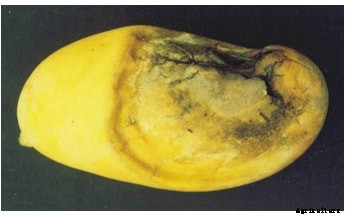
Affected fruits show characteristic yellowing with irregular dull grayish spots, which develop into the black necrotic area with growth of black mould. Tissue below and around the spots disintegrate and emit foul dour. The fruits rot very fast. The rotting may; start from any point but injury is essential for the start of rot. It may also start form the stem end as there remains natural opening.
Gestione
Reason:Many post harvest diseases begin while the crop is still in the field. Some harvested fruits carry latent infection that may not be detected at harvest level.
Reason:Bruises, wounds and other mechanical injuries serve as portal of entry for microorganisms.
Reason:These may carry the microorganisms from the field.
Reason:Free moisture on the fruits surface enhances the growth of spores.
Reason:Diseased commodities may contaminate healthy fruit when they come in contact with diseased ones.
Reason:Disease-causing microorganisms do not grow at low temperatures. Growth will resume upon transfer of commodity to room temperature.
Reason:Moist conditions favour the growth and multiplication of disease- causing microorganisms.
Reason:Dirty and unsanitary containers and areas may serve as sources of infection.
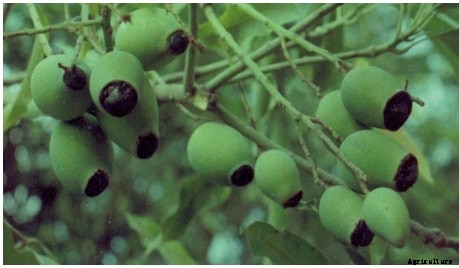
Symptoms:Symptoms become visible when the mango fruits attain some size. Small etiolated area develops near the distal end of the fruit which gradually spreads, turns nearly black and covers the tip of the fruit completely. The black area remains hard and the growth of the fruit is checked.
Through toxic gas viz. Sulphurdioxide, etilene, carbonmonooxide and fluoride emitting from brick klins operating nearby orchard.
Symptoms:First, water soaked grayish spots develop on the lower side of the fruit. Late, the spots enlarge and develop into dark brown necrotic area. The internal tissue starts disintegrating. The pericarp and mesocarp is disintegrated exposing the flesh.
Yellow coloured droplets also come out and such affected fruits drop easily.
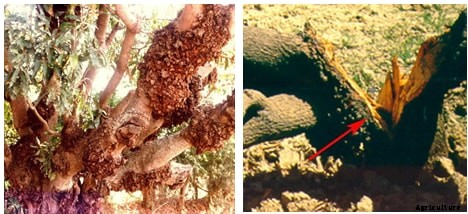
Symptoms:This abnormality is characterized by formation of several fruit lets at the tip of panicle. The fruitlets are darker green in colour and their shape is slightly curved than the normal fruits. These fruits generally hang for more time compared to some normal fruits, which subsequently drop due to other fruit drop reasons. However these fruitless do not grow more and later drop. The fruits do not have formation of seeds.

Symptoms:Woody galls of 10-15 inches diameter are formed on limbs and branches. The galls are abundant on CVS. Chinnasuvarnarekha, Langra and moderate in Neelam.
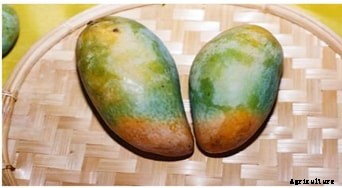
Symptoms:The malady is severe in late maturing Neelam and Mallika varieties particularly in delayed harvest leading to substantial loss. The fruits with red nose are unfit for export. Numerous red nosed fruits are seen on tree during fag end of summer with onset of showers. Red nose gradually becomes soft and rot.
Gestione
Symptoms:Tumors of pea to marble size develop on fruit and are very ugly to look at. The stylar end part is much affected while stem end is practically free from tumors
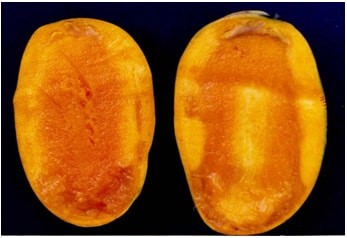
The problem of jelly seed have been recorded in several mango varieties. Però, Dashehari cultivar of mango is found more susceptible to this disorder as compared to other cultivars like Chausa and Langra. In this disorder, the pulp near the stone becomes jelly like with tissue disintegration while the outer pulp near the peel is normal. The taste of fruit becomes repulsive and loose table quality. From the outer appearance fruits look normal. It incidence is more in Lucknow region particularly in late harvested fruits (Fig. 74).
Most of the prone orchards of this disorder have been found with imbalance of nutrients. Among the nutrients, P and Zn deficiency were more prevalent. Slow movement of nutrients particularly Ca++ to the fruits from soil and leaf through transpiration stream in Dashehari at maturity was found to be one of the reasons for this disorder.
Gestione
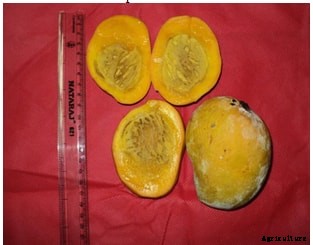
Alphonso mango, which is the main export cultivar, suffers from a serious malady known as spongy tissue or internal breakdown in the ripe fruits. This disorder renders the fruit unfit for consumption and hence, it has become a bottleneck in export and expansion of its cultivation in the State of Maharashtra and Gujarat where it is grown commercially. There are many biochemical changes associate with spongy tissue; però, no conclusive results have been obtained to control this malady. Convicting heat arising from soil and intense solar radiation are reported to be the main cause for this disorder.
Symptoms:Scorching of leaf margins is the characteristic symptom of potassium deficiency. Scorching starts from tip downwards. Fruit quality is reduced. Trees with potassium deficiency are easily prone to pest and disease attack.
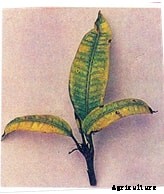
Symptoms:The leaves become small and narrow with leaf margins bent upward or downward. Inter nodal length is reduced drastically and the twig with crowded leaves gives rosette appearance. Pale inferential areas and green veins are typical of zinc deficient leaves. The tree with zinc hunger does not grow well and the yield, size and quality of the fruit are reduced. Small plants with severe zinc deficiency may die. Zinc deficiency is conspicuously seen in alkaline, saline and sandy soils.
Symptoms:The leaves loose green colour and turn white and is called Bleaching. The size of the leaf is reduced. In severe cases of iron deficiency, the leaves dry from tip downwards. The deficiency is common in soils with high calcium content. Quindi, the effect is known as calcium induced iron chlorosis.
Gestione
Symptoms:Cracking of fruit is the characteristic symptom of boron deficiency. Lusterless leathery leaves with thickened veins are the other associated symptoms. Brown areas in yellow fruit pulp are conspicuous.
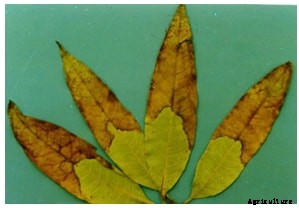
Symptoms:The leaves are scorched due to excess salt in soil or irrigation water. The leaves lose their natural colour and turn to bronze colour. Tip burning is also seen in severe cases of salt injury.
Management:
Symptoms:Copper deficiency symptoms frequently develop on young trees which generally occur due to heavy nitrogenous fertilization. It may also be accompanied by Zinc deficiency symptoms. The appearance of weak terminal shoots followed by defoliation and die back of branches, on the top of long drooping or shaped branches of the proceeding cycle of growth usually makes evident that copper is needed
Survey:To monitor the initial development of pest and disease in the endemic areas survey is prerequisite. Perciò, for field scouting farmers should be mobilized to observe the pest and disease occurrence at the intervals as stipulated under different development stages. The plant protection measures are required to be taken only when bio control potential does not show promise and pest and disease incidences shows increasing trend.
Field Scouting:Field scouting for pests/disease and bio control fauna/flora by extension agencies and farmers once in a fortnight should be undertaken to assess increasing/decreasing trend in the pest/disease incidence and availability of bio control potential. This should be done soon after the appearance of new flush after the fall of old leaves as such stage of the crop having succulent tissues in valuable to attack by pests and diseases. The state Departments of Horticulture should make all possible efforts by using different media, mode and publicity to inform the farmers for field scouting in the specific crop area having indication of pest and disease build up.
A large number of parasites, predator and pathogens are very active against pests of mango in the fields. Questi sono Rodolia fumida, Suminus renardi, Coccinellids, Beauveria bassiana, Verticillium lacani, Mallada boninensis, Chrysopa spp., Tertrastichus spp., Trichoderma spp., Gonatocerus spp, Podynema spp., Platygaster sp, Eupulmus sp., Systasis dasynearue, Micronimus timidis, Baccha pulchrifrons, eccetera . which pay a significant role in population suppression of various insect pests and diseases. These should be conserved in the field.
Chemical pesticides recommended for control of diseases and pests are given in the text.